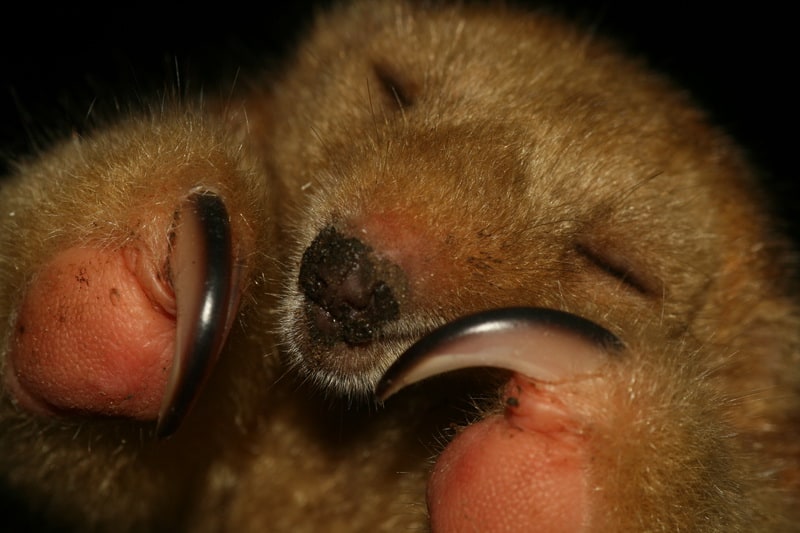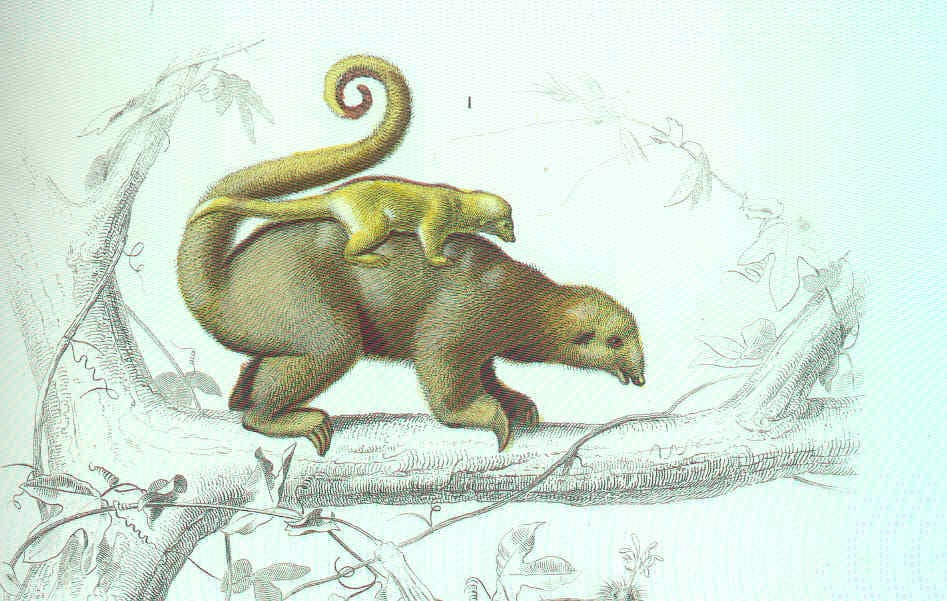The silky anteater (Cyclopes didactylus), also known as the pygmy anteater and two-toed anteater, is a furry forest-dwelling mammal of the Neotropics. Its scientific name means “two-toed circle-foot,” referring to the two large claws on each front foot which appear to encircle whatever branch the animal is clinging to. It is the smallest and most mysterious of the American anteaters, with little still known about their basic biology and ecology. Read on to find out more about these cute creatures!
How Are Silky Anteaters Classified?

The silky anteater’s closest living relatives are the fellow anteaters of the suborder Vermilingua (meaning “worm tongue”), the giant anteater (Myrmecophaga tridactyla), and the northern and southern tamanduas (Tamandua mexicana and Tamandua tetradactyla). Those animals are classified into the family Myrmecophagidae (literally “ant eater”), while the silky anteater is the only living member of the sister family Cyclopedidae (“circle foot”). Only one other extinct species from this family is known, Palaeomyrmidon incomtus, which lived in Argentina during the Late Miocene 7 to 9 million years ago.
Scientists have traditionally considered the silky anteater a single species with seven subspecies. However, a full comprehensive study in 2017 proposes that silky anteaters should actually be recognized as at least seven separate species based on differences in genetics, morphology, and geography. We list these species in the next section.
Where Do Silky Anteaters Live?

Silky anteaters have a distribution that includes an isolated population on the east coast of Brazil, separated from the main range by some 1000 km.
©Chermundy, IUCN Red List of Threatened Species, species assessors and the authors of the spatial data via Wikimedia Commons / CC BY-SA 3.0 – Original / License
Silky anteaters range across southern Mexico, Central America, and northern South America, as well as the island of Trinidad. There is also a disjunct population in the Atlantic Forest of eastern coastal Brazil. The ranges of each of the seven proposed species are below:
- Cyclopes catellus – Bolivia
- C. didactylus – Guyanas, eastern Venezuela, Trinidad, Atlantic Forest and northern Brazil
- C. dorsalis – western Ecuador, southwestern to northern Colombia, Central America, and southern Mexico
- C. ida – western Brazil, eastern Ecuador, eastern Colombia, and Peru
- C. rufus – Brazil (Rondônia)
- C. thomasi – Central Peru and extreme western Brazil (Acre)
- C. xinguensis – Brazil between the Madeira and Xingu Rivers below the Amazon River
Silky anteaters inhabit a variety of different forest types from sea level to 1,500 m (4,900 ft), including semi-deciduous, evergreen, tropical, moist lowland, gallery, mangrove, and secondary forests. They prefer areas with a continuous canopy so that they can move about without needing to descend from the trees. Males have larger home ranges that overlap with those of multiple females.
What Do Silky Anteaters Look Like?

Their golden, silky fur gives the silky anteater its name.
©rob21 via iNaturalist Canada / CC BY 4.0 – Original / License
Silky anteaters are the smallest of all living anteaters. Adults grow to a total length of only 36 – 45 cm (14 – 18 in.), more than half that length being the tail, which grows to 17 – 24 cm (6.7 – 9.4 in.) long. They also weigh just 175 – 400 g (6.2 – 14.1 oz.).
Silky anteaters are named for their soft, silky, dense fur. This fur is generally yellowish with a silvery sheen. However, different species/subspecies may have slight variations, including a dark streak down the front or back or paler limbs or undersides. Silky anteater fur also looks remarkably similar to the fibers of the large seed pods of the silk cotton trees (Ceiba sp.) they often inhabit, making for excellent camouflage.
Silky anteaters have two large clawed toes on each forefoot, with the hindfeet also highly modified for climbing with four clawed toes on each. The soles of their feet are hairless and reddish.
Like other anteaters, silky anteaters are edentate, meaning they don’t have any teeth. Instead, they use their long, sticky tongues to eat. They also have two large black eyes adapted for night vision.
Silky Anteater Behavior

The silky anteater curls up into a little furry ball when it sleeps.
©Gypsy Sleuth Travel/Shutterstock.com
Silky anteaters are nocturnal, arboreal animals. These slow creatures spend their nights foraging for food and their days curled up asleep amongst vines or tree branches. They spend almost their entire lives in the forest canopy, rarely, if ever, descending to the ground. Adults are usually solitary except for parents with young.
Like other anteaters, the silky anteater defends itself when threatened with its powerful front claws. When threatened, it will rear up on its hind legs (with the help of its prehensile tail if hanging on a tree branch), then hold its forefeet close to its face, ready to quickly strike anything that comes too close.
What Do Silky Anteaters Eat?

Like other anteaters, silkies can use their strong claws to break open insect nests.
As their name suggests, silky anteaters are insectivores and especially love to eat ants! They can consume anywhere from 700 – 5,000 ants a night. In addition to dining on ant nests, they also attack both wasp nests and termite nests. They sometimes also eat small beetles.
Silky Anteater Predators

Harpy eagles and other large birds of prey can pluck silky anteaters from the trees.
©Chepe Nicoli/Shutterstock.com
Silky anteaters are hunted by large native birds of prey, including harpy eagles (Harpia harpyja), hawk-eagles (Spizaetus sp.), and spectacled owls (Pulsatrix perspicillata). They are not hunted by humans for food. However, there are reports of them occasionally being captured for the local pet trade.
Silky Anteater Reproduction and Lifespan

Like other anteaters, baby silkies sometimes get a ride on a parent’s back.
There is still not much known about the mating habits of silky anteaters. Females give birth to a single pup after a pregnancy of 120 – 150 days, usually in September or October. However, some sources report females may give birth to a second pup at different times of the year. The young are born fully furred and look like little versions of their parents. Both parents help take care of the baby, with the mother providing milk and both parents feeding it regurgitated insects as it grows. The young is placed in a nest of dead leaves in a tree hole for up to eight hours a night while the parents go out to forage.
The lifespan of the silky anteater is only believed to be about 2 years in the wild.
Silky Anteater Conservation

It is unknown how many silky anteaters there are in the wild, though their population is presumed to be healthy overall despite ongoing habitat loss.
The IUCN Red List still recognizes the silky anteater as a single species, which it lists as Least Concern. This assessment is based on “its wide distribution, presumed large population, its occurrence in a number of protected areas, its tolerance of a degree of habitat modification, and because it is unlikely to be declining fast enough to qualify for listing in a more threatened category.” The top threat to the species is deforestation.
However, they also have a separate entry for the isolated northeastern Brazil subpopulation, which is currently listed as Data Deficient. The IUCN believes that because of the especially rapid and ongoing loss of this subpopulation’s Atlantic Forest habitat due to the spread of sugar cane plantations, it is “highly probable” that this population warrants a threatened status listing, but “field studies are urgently needed…to obtain sufficient information for an appropriate assessment of its conservation status.”
Unfortunately, silky anteaters remain poorly studied in the wild and are rare in captivity, making conservation planning difficult. It also doesn’t help that we aren’t even sure how many species there actually are. There is still so much left to learn about these cute tree-dwelling, insect-eating furballs of the Neotropics!
Thank you for reading! Have some feedback for us? Contact the AZ Animals editorial team.








